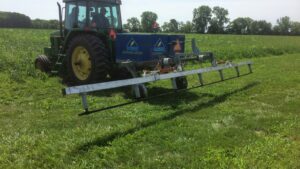It might not earn a spot in the record books everywhere, but 2019 will likely be etched in the memory of many farmers and the agriculture industry as one of the most challenging growing seasons in recent history.
Boyd Carey, regional agronomy lead for Bayer Crop Science, considers the current calendar year to be “unprecedented” in his 25 years in the industry. Uncertainty in the farm economy, coupled with the struggle to get crops planted, has really upped the pressure on farmers and the professionals who serve them.
The season has presented unique challenges in all aspects of crop production, and weed control is among them. “We always have weeds, but higher soil moisture levels typically mean we see even more weed pressure and repeated germination of new flushes. Because the rain delayed farmers from getting in to the fields, the moist and warm growing conditions at planting were very favorable for both the crops and weeds to emerge and grow very quickly,” Carey says.

Carey notes there haven’t been major surprises in terms of new weeds due to the extra moisture, but the times at which they germinate or appear within the soybean growing cycle has been impacted.
“The wet weather shifted soybean planting later, so the weeds we’re used to seeing at certain points of the soybean growing cycle may be different than usual,” he says. For instance, some fields likely saw less giant ragweed, an early-germinating weed, but water hemp, a weed that germinates later into the season, could be more prevalent and soybean canopies may not be adequate to hold it back.
“Weed species may have shifted this year, but the populations are still there,” Carey says.
The Ability to Adjust
In a year like this one, having the ability to adjust when herbicide applications are made is critical, and it’s an option that users of the Roundup Ready Xtend Crop System are relying on in 2019. XtendiMax herbicide with VaporGrip Technologycan be applied pre-plant in soybeans or anytime through soybean germination and up to 45 days after planting or the R1 growth stage, whichever comes first, Carey says. Check your individual situation for potential state-specific application cut-off dates.
“There can be a lot of pressure on farmers with many acres, or retailers with many commercial customers, to get herbicides applied, and this year that window of time is compressed. The benefit of the Roundup Ready Xtend Crop System is that they can adjust that timing across their operations to manage the overall workload requirements,” he adds.
He notes that most herbicides designed for post-emergence use in soybeans must be applied before flowering, resulting in an extended period of time after flowering initiation when weed control is still needed but other options are limited. “The only way to get that weed control is through soil activity, so the additional 14 days of soil activity that XtendiMax with VaporGrip Technology offers on certain small-seeded broadleaf weeds is very critical,” Carey says.
In some regions of the country where the spring rains tapered off and drier than normal conditions have set in, farmers are finding that XtendiMax with VaporGrip Technology and Warrant Herbicide work well together to control germinating weeds when moisture levels are fluctuating.
“From a soil activity standpoint, XtendiMax with VaporGrip Technology and Warrant complement each other. Xtendimax with VaporGrip Technology provides soil activity on certain germinating weeds, even with very limited soil moisture. It gets to work right after it’s applied. Warrant is a true residual in that it does require more moisture to be activated, but it provides a much longer residual effect. That makes the two an ideal combination,” Carey says.
To learn more, visit www.RoundupReadyXtend.com













